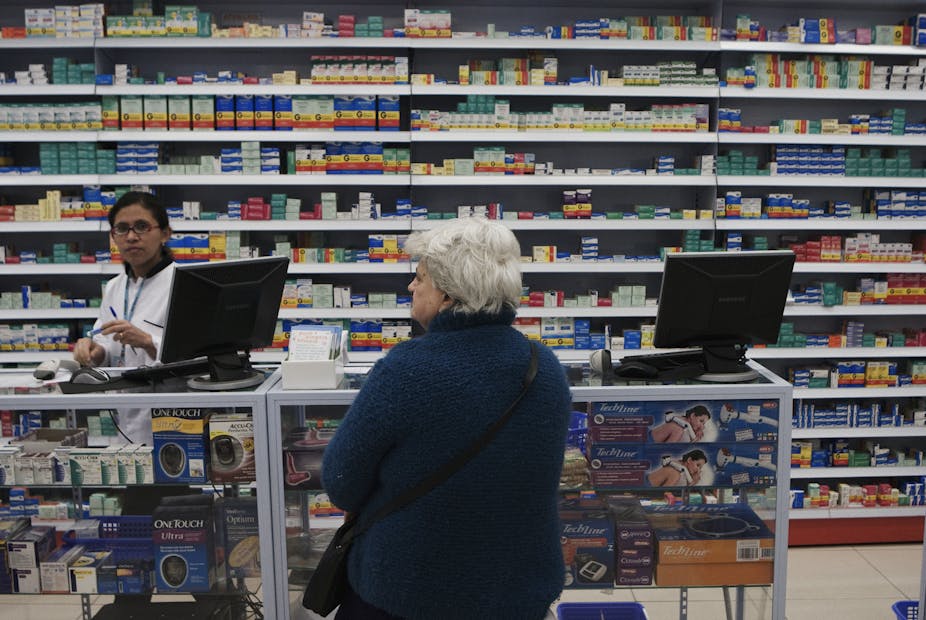The Community Pharmacy Agreement is a five-year agreement (now in its fifth cycle) that governs how pharmacies supply medicines listed on the Pharmaceutical Benefits Scheme (PBS). While the average Australian makes more than 14 visits to a community pharmacy every year, not many know about how this agreement impacts pharmacy in Australia.
Pharmacies buy medication from wholesalers, sell them to people who bring in prescriptions and are reimbursed by the government for drugs listed on the PBS. They’re also paid for the professional advice they provide when dispensing those medicines.
Patients pay a contribution towards the cost of their medication to the pharmacist, who then claims from the government the difference between what they paid the wholesaler and the patient contribution. In the financial year ending June 30 2014, the government spent $9.1 billion on PBS-listed drugs. Exactly what this money went to was governed by the Community Pharmacy Agreement.
Getting approval
The agreement is formed between the Pharmaceutical Guild of Australia (PGA) and the Commonwealth government because of a key clause in the National Health Act 1953. This says any agreement relating to how the Commonwealth remunerates items on the PBS needs to be made with the PGA or another pharmacists’ organisation that represents the majority of “approved pharmacists”.
Approval requires pharmacists to apply to the Australian Community Pharmacy Authority (ACPA), an independent statutory authority that considers applications to supply PBS medicines under Section 90 of the Act. As part of assessing applications, the ACPA has to consider the location of the proposed pharmacy because we need pharmacies to form a distribution network so everyone in the country has access to PBS-listed drugs.
In Australia, you can only own a pharmacy if you are a qualified pharmacist. So the people representing the approved “Section 90” pharmacies are pharmacist-owners, and the Pharmaceutical Guild is their professional organisation.
A brief history
The first Community Pharmacy Agreement (CPA) began in 1991 and its focus was on optimising the distribution of pharmacy services around the country. At the time, there were concerns that more pharmacies were located in metropolitan areas while regional and rural Australia went without. The agreement introduced a new remuneration framework for pharmacies supplying PBS medicines and created incentives for pharmacies in rural and remote areas.

The CPA was also a response to concerns in government and the pharmacy profession about Australia’s large pharmacy-to-population ratio (much higher than other Western countries) and the lack of consistency in various financial drivers across the profession, including for mark-ups and fees for dispensing PBS medicines.
Under the first CPA, the number of pharmacies in Australia fell from 5,500 to 4,950 by the end of 1995. This included voluntary closures of over 600 pharmacies and more than 60 mergers, and cost the government more than $50 million.
Each subsequent agreement has helped maintain the principle of equal distribution of pharmacies across the country through controls placed on the profession via the location rule, which says a pharmacy may not open within 1.5 kilometres of an existing one.
The fifth Community Pharmacy Agreement, which commenced on July 1 2010, also contains remuneration ($663 million, or less than 5% of the total CPA budget) for clinical services that enhance patient medication management. These include one-on-one medication reviews, which can take between 20 and 30 minutes in-store, or up to an hour in the patient’s home.
The current CPA totals $15.4 billion, with the bulk of the funding ($13.8 billion) allocated directly to individual pharmacies for PBS-related services.
A final part of the puzzle
Another critical part of the CPA is the Community Services Obligation (CSO), which is an arrangement between the government and pharmaceutical wholesalers. The core of the CPA arrangement is access to PBS medicines and wholesalers who supply the pharmacies are pivotal players in the supply chain.
The CPA provides direct financial support ($950 million) to certain pharmaceutical wholesalers for any additional cost they may incur in providing the full range of PBS medicines. This ensures the full range is available regardless of pharmacy location and relative cost of supply. It also helps ensure that low-volume PBS medicines, which are often very high-cost drugs, are delivered to community pharmacies anywhere in Australia within 24 hours.
Since its inception 25 years ago, the intent of the Community Pharmacy Agreement has been to ensure all Australians have access to PBS-listed medications, no matter where they live. Australia’s network of around 5,500 community pharmacies have played a pivotal role in realising this goal.

